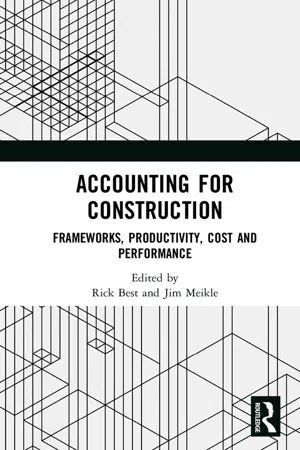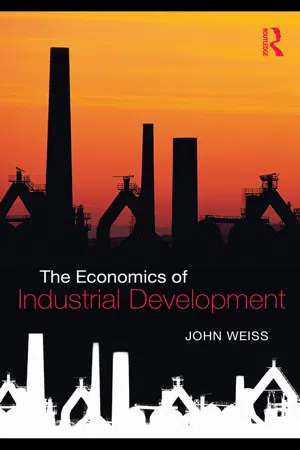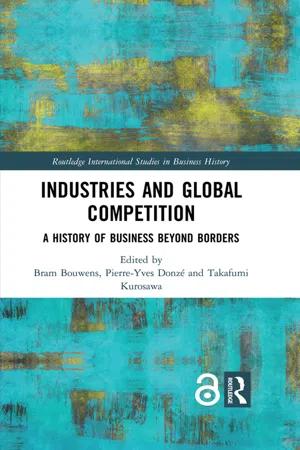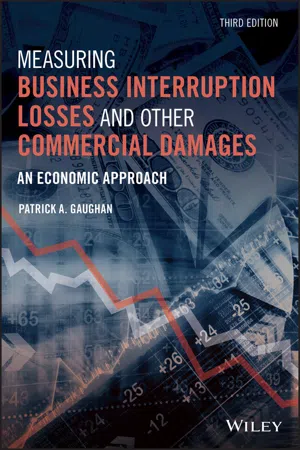Business
Industry Classification
Industry classification is a system used to categorize businesses into different sectors based on their primary economic activity. This classification helps in organizing and analyzing economic data, understanding market trends, and comparing companies within the same industry. It is commonly used by investors, analysts, and policymakers to make informed decisions and assess the performance of businesses.
Written by Perlego with AI-assistance
Related key terms
Related key terms
1 of 4
Related key terms
1 of 3
9 Key excerpts on "Industry Classification"
- eBook - ePub
Accounting for Construction
Frameworks, Productivity, Cost and Performance
- Rick Best, Jim Meikle(Authors)
- 2019(Publication Date)
- Routledge(Publisher)
An Industry Classification system collects companies and other organizations into groups with similar characteristics. The first Standard Industrial Classification of All Economic Activities (SIC) was established in the United States in 1937, with the United Nations International Standard Industrial Classification (ISIC) following in 1948. This had its most recent revision in 2008: This fourth revision of ISIC enhances the relevance of the classification by better reflecting the current structure of the world economy, recognizing new industries that have emerged over the past 20 years and facilitating international comparison through increased comparability with existing regional classifications. (UN Statistical Division 2008: 3) Since 1948 most countries have used the ISIC classification system or have developed national classifications derived from it, and while today there are many national variants on the ISIC format there is also a great deal of commonality. Economic activities are subdivided in a four-level structure. Activities are first divided into ‘sections’, which are alphabetically coded. These sections divide productive activities into broad groupings such as ‘Agriculture, forestry and fishing’ (A), ‘Manufacturing’ (C) and ‘Information and communication’ (J) - eBook - ePub
Investments
Principles of Portfolio and Equity Analysis
- Michael McMillan, Jerald E. Pinto, Wendy L. Pirie, Gerhard Van de Venter(Authors)
- 2011(Publication Date)
- Wiley(Publisher)
4.2.4. North American Industry Classification SystemJointly developed by the United States, Canada, and Mexico, the North American Industry Classification System (NAICS) replaced the Standard Industrial Classification (SIC) system in 1997. NAICS distinguishes between establishments and enterprises. NAICS classifies establishments into industries according to the primary business activity of the establishment. In the NAICS system, an establishment is defined as “a single physical location where business is conducted or where services or industrial operations are performed” (e.g., factory, store, hotel, movie theater, farm, office). An enterprise may consist of more than one location performing the same or different types of economic activities. Each establishment of that enterprise is assigned a NAICS code on the basis of its own primary business activity.4NAICS uses a two-digit through six-digit code to structure its categories into five levels of detail. The greater the number of digits in the code, the more narrowly defined the category. The five levels of categories, from broadest to narrowest, are sector (signified by the first two digits of the code), subsector (third digit of the code), industry group (fourth digit), NAICS industry (fifth digit), and national industry (sixth digit). The five-digit code is the level of greatest amount of comparability among countries; a six-digit code provides for more country-specific detail.Although differences exist, the structures of ISIC, NACE, ANZSIC, and NAICS are similar enough that many of the categories from each of the different classification systems are compatible with one another. The U.S. Census Bureau has published tables showing how the various categories of the classification systems relate to one another.54.3. Strengths and Weaknesses of Current Systems - eBook - ePub
Improving Profitability Through Green Manufacturing
Creating a Profitable and Environmentally Compliant Manufacturing Facility
- David R. Hillis, J. Barry DuVall(Authors)
- 2012(Publication Date)
- Wiley(Publisher)
Economic Classification Policy Committee (ECPC), Statistics Canada, and Mexico’s Instituto Nacional de Estadística y Geografía. NAICS provides a solid foundation for creating a model or taxonomy of manufacturing. The NAICS system is used by statistical agencies to codify business and industrial establishments when collecting economic data. It is also used for other, nonstatistical purposes: administrative, regulatory, contracting, and taxation. Often contracting agencies require firms to register their NAICS codes to determine their eligibility to bid on contracts. NAICS is the guidebook used by business, industry, and governmental agencies to classify industry in the United States, Canada, and Mexico. It should be kept in mind that NAICS is an Industry Classification system, not a product classification system. Another system, called the North American Product Classification System (NAPCS), is currently being developed to integrate all of the industries defined in NAICS in terms of their products. The emphasis will be on goods produced and services provided. NAICS was built on a solid foundation established by its predecessor, the Standard Industrial Classification Index (SIC), which in 1939 became the first standard industrial classification for the United States. The first List of Industries for manufacturing in the United States was published in 1938. This list was consolidated with the 1939 List of Industries for nonmanufacturing industries to become the SIC. For hundreds of years manufacturing establishments have developed and refined best practices for using tools, manufacturing processes, production techniques, machines, and manufacturing systems for the production of products. Industrial production is a term used by the Federal Reserve Board (FRB) to refer to the total output of U.S. factories and mines and is a key economic indicator for the U.S. economy - eBook - ePub
- Hiromi Kubo, Thomas J. Ottaviano(Authors)
- 2016(Publication Date)
- Business Expert Press(Publisher)
Although the SIC has not been updated since 1987, many business-specific databases and tools still use both the SIC and the NAICS. Therefore, understanding the mechanics of the SIC and the NAICS benefits you in performing industry research more effectively. For example, using NAICS code 485320 as a search query in the ABI/INFORM Complete database pulls out reports and articles only about the industry that deals with chauffeured limousine services from various trade magazines, newspapers, and academic journals, excluding entries on other industries such as airport shuttle service (NAICS 485999), limousine rental (NAICS 532111), and limousine manufacturing (NAICS 336211). Some other helpful Industry Classification systems that might come across in your research paths are the United Nation’s International Standard Industrial Classification of All Economic Activities (ISIC), the European Union’s Statistical Classification of Economic Activities in the European Community (NACE), and the United Kingdom Standard Industrial Classification of Economic Activities (UKSIC). Some companies and resources even develop their own Industry Classification system. For example, Bloomberg uses a Bloomberg Industry Classification system (BICS), and McGraw Hill Financial and MSCI have developed and trademarked the Global Industry Classification Standard (GICS). It is important to recognize that, while the NAICS was developed by the U.S. Government, the government typically does not assign a NAICS code to a particular company. This means that individual resources assign a company the NAICS codes that they believe are most appropriate. Most resources list the primary revenue generating business as the primary industry, but in many cases it is difficult (or even impossible) to determine which industry generates the most revenue. Sometimes this results in one database listing very different NAICS codes for a company than another database - eBook - ePub
- John Weiss(Author)
- 2010(Publication Date)
- Routledge(Publisher)
Productive activity is conventionally classified using the United Nations International Standard Industrial Classification (ISIC) which divides all economic activity into three broad divisions – agriculture, industry and services. In principle, the general term industry can be used to reflect all types of economic activity (e.g. the transport industry). Its narrower meaning as used here refers to activity where inputs are transformed into a different form of product, so that value is created at different stages of the production process. This activity can be thought of as manufacturing and will include the processing of natural resource-based products from agriculture and mining. Hence, industry in this narrow sense refers to manufacturing industry. However, a common statistical definition of industry includes not just manufacturing, but also mining, construction and the utilities electricity, water and gas (see Box 1.1). Industrialisation is, therefore, the process under which manufacturing comes to play a significant role in total activity of an economy. What is a significant threshold beyond which industrialisation can be said to be achieved is open to debate; Box 1.1 Industrial classification The ISIC classification revision 3 divides productive economic activity into three broad categories with further sub-divisions within these: Agriculture including forestry and fishing (divisions 1–5), Industry including mining, manufacturing, construction, electricity, water and gas (divisions 10–45) and Services including transport, retail and wholesale and financial services (divisions 50–99). Manufacturing is sub-divided at the 2-, 3- and 4-digit levels - eBook - ePub
Industries and Global Competition
A History of Business Beyond Borders
- Bram Bouwens, Pierre-Yves Donzé, Takafumi Kurosawa(Authors)
- 2017(Publication Date)
- Routledge(Publisher)
“Manufacturing”), “economic major group” (e.g. “Chemical and Allied Products”), “industry group” (e.g. “Drugs”) and “industry” (e.g. “Pharmaceutical Preparations”). However, SIC is nothing more than one among a countless number of industrial taxonomies. Both differences among national SICs and constant revisions of each SIC suggest this fact. The criteria of hierarchy and grouping can be very diverse. In addition, multiple criteria are used in a single SIC code system: products category (e.g. “Food and Kindred Products” [SIC 20], “Beverages” [SIC208] and “Malt Beverages” [SIC2082]); use, function and produc t (e.g. “Transportation Equipment” [SIC37], “Motor Vehicles and Equipment” [SIC371] and “Motor Vehicle Parts and Accessories” [SIC3714]): technological feature, processes and materials (e.g. “Chemicals and Allied Products [28], “Plastic Material and Synthetic”[SIC282] and “Cellulosic Manmade Fibers” [SIC2823]); scope of market (e.g. “Health Services” [SIC80], “Hospitals” [SIC806] and “Psychiatric Hospitals” [SIC8063]); social function (e.g. “Engineering, Accounting, Research, Management and Related Services” [SIC87], “Management & Public Relations Services” [SIC874] and “Management Consulting Services” [SIC8742]). Hence, the study of an industry needs to focus on the appropriate level of the multi-layered hierarchy, according to the aim of its analysis. It is also important to know what kind of factors (i.e. elements to form the boundary of industry) defines the layers of the hierarchy. Discussions on “product differentiation strategy” or “high-value-added product” are good examples. Such an analysis postulates a specific view of the boundary of the segment - eBook - ePub
Measuring Business Interruption Losses and Other Commercial Damages
An Economic Approach
- Patrick A. Gaughan(Author)
- 2020(Publication Date)
- Wiley(Publisher)
36,012 34,326 33,879 158,053 553,657 404,591 196,206a Includes categories not shown separately.b Data are for roughly similar categories in SIC classification system.c SIC tobacco only, 1970–1992.Industry data in the Annual Survey of Manufacturers are organized using Standard Industrial Classification (SIC) codes. This is often the case for both government and private data sources. Knowing a business’s SIC code can enable the expert to locate industry data more quickly. It is therefore useful to have an understanding of this classification system.STANDARD INDUSTRIAL CLASSIFICATION CODES
SIC codes are assigned to specific industries and product lines according to a classification system that was designed by the federal government’s Office of Management and Budget.5 The system was first developed in the 1930s and has been revised periodically since that time. Industries are classified broadly using two‐digit groups or more narrowly using three‐ or four‐digit groups. The four‐digit numbers range from 0000 to 9999; the range 2000 to 3999 is reserved for the manufacturing sector. A “9” appearing in the third or fourth position of the classification code usually designates miscellaneous industry groups that are not otherwise classified. Table 4.5 provides a breakdown of the various SIC categories.North American Industry Classification System
Given the many structural changes that have taken place in the U.S. economy, including the growth of the service sector relative to the manufacturing sector, an updated Industry Classification was developed. This system, called the North American Industry Classification System (NAICS), features 350 new industries and 9 service industry sectors.6 The NAICS system is generally comparable to the United Nations’ Statistical Office’s International Standard Industrial Classification System (ISIC). Federal government agencies implemented the system in 1999 using data from the 1997 economic census. It uses a six‐digit system to categorize specific industries; the first two digits designate the sector; the third designates the subsector; the fourth, the industry group; and the fifth and sixth digits designate the NAICS and the national industries. The system focuses on the economies of the United States, Canada, and Mexico. The sectors in the NAICS system are shown in Table 4.6 . Various websites exist that can provide NAICS codes for various industries.7 - eBook - ePub
Service Industries
A Geographical Appraisal
- Peter W. Daniels(Author)
- 1985(Publication Date)
- Routledge(Publisher)
Table 1.2 , n. 2). Essentially these orders are derived from a classification based either on the kind of raw materials which are used, such as non-ferrous metals or oil for the petroleum industry, or by reference to the nature of the final product, such as electrical goods, or cars, vans and lorries in the case of the vehicle industry. Such an approach is not very helpful when applied to services; many require a personal input for example, domestic or office cleaning, or a medical/legal practice, and this does not lead to any material output other than a cleaner home or office, or advice from the medical practitioner or legal adviser about how to resolve a problem or to complete a house purchase. There is, therefore, little to be gained by classifying services with reference to output in the way possible for primary and secondary (manufacturing) activities.Table 1.2 Sectoral classification of industry ordersWhen a list of industry orders has been agreed—and there is now some, although far from complete, uniformity between national censuses—it remains to decide which orders should be included in the service sector. Inevitably, perhaps, there is no internationally agreed definition although both the European Economic Community through its Nomenclature des Activités Économiques dans les Communautées Européennes (NACE) (see Statistical Office of the European Communities, 1970) and the United Nations (1948) through its International Standard Industrial Classification (ISIC) have endeavoured to encourage a standardized definition in the interests of more effective comparative analyses (see Table 1.2 ). Perhaps the definition of the service sector should vary according to the purpose of individual studies, but this only obviates the necessity to delimit it in a consistent way.However, the UK for example has for some time deviated from these two schemes. The first Standard Industrial Classification (SIC) for the UK was issued in 1948, with subsequent revisions in 1958 and 1968 (Department of Employment, 1983). The most recent revision (1980) not only takes into account the changing structure of British industry, but brings the classification closer into line with NACE and ISIC. There are substantial differences between the 1980 SIC and its predecessors both in the structure of the classification and the numbering system used. Most notable is the use of a four-tier structure with a hierarchical decimal numbering system rather than the twenty-seven orders in the 1968 SIC divided into minimum list headings (MLHs) with numbers unrelated to the roman numerals by which orders are identified. The 1980 SIC is divided into 10 divisions, 60 classes, 222 groups and 334 activity headings and a broad comparison, as it relates to service industries, is given in Table 1.3 - Jay J. R. Zajas, Olive D. Church(Authors)
- 2021(Publication Date)
- CRC Press(Publisher)
Business Week), these sources, in tandem with the SIC codes, provide an excellent overview of business companies. This section also examines how firms use telecommunications and some of the challenges facing individuals in today's job market.OBJECTIVES
- Discuss the major issues described in the unit and reach consensus on learning outcomes as compared with section objectives.
- Interview people in a variety of local businesses (from several SICs) to identify how their firms use telecommunication systems and business principles.
- Input interview data to a computerized database and share information with group members by using e-mail or fax.
- Collect data on a variety of multinational businesses from several SICs and participate with your group in preparing a multimedia demonstration to share findings.
- Using information from the two SIC databases, compose career advice and dictate a short report to your partner.
- Participate with your group in discussing case studies.
- Solve business problems and make economic decisions, using whole-brain thinking and one or more telecommunication systems.
- Convene with your group to assess progress on the major project, assign new tasks and responsibilities, and reach consensus on learning outcomes in comparison with section objectives.
Passage contains an image
Chapter 7 Standard Industrial Classifications
DOI: 10.4324/9781003249023-12Business firms, consumer goods enterprises, and nonprofit organizations are classified under several well-defined categories. The Internal Revenue Service (IRS) also uses these classifications when it requires entrepreneurs to report income from their small business operations.The channels of distribution are reported with the standard industrial classifications (SICs). Buy-and-sell transactions take place along these channels and are conducted between and among companies as well as between companies and consumers. Both communication and transportation systems are utilized. Products are bought and sold using communication and record systems, whether conducted via oral, print, or telecommunication media. Goods are then shipped using private transportation systems or services such as Federal Express, UPS, or the public mail system.
Index pages curate the most relevant extracts from our library of academic textbooks. They’ve been created using an in-house natural language model (NLM), each adding context and meaning to key research topics.
Explore more topic indexes
Explore more topic indexes
1 of 6
Explore more topic indexes
1 of 4








